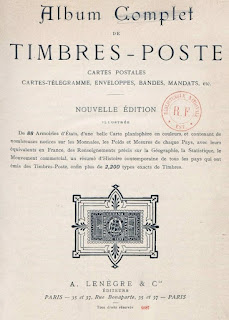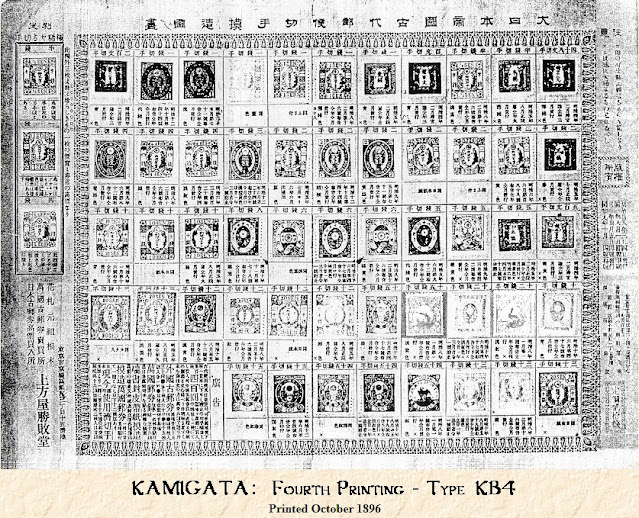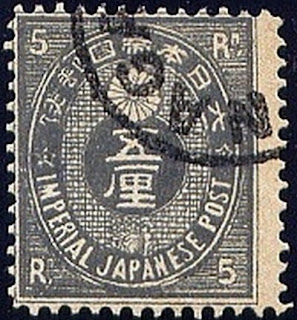2021-11-30
12Sen ID Chart
- KIKU crest size and details
- size and shape of "balon montee"
- corner "Sn/"
- oval kanji characters
6Sen ID chart ...
EURO signed facsimile 2019 from Hungary. 6 and S resemble LeNegre type - artist unknown ...
1877 Postal volume increased year by year. Printing using hand-engraved plates was no longer able to keep pace with the demand for stamps. Under the guidance Edoardo Chiossone, an Italian, who was invited by the mint, stamps were produced using the new method of relief printing.
The stamps are commonly known as the 'Small Coin stamps,' for the picture in the center of the design. These were used for many years, from 1876 to 1899, and were the first stamps to have the words 'Refined edition,' indicating the production method, printed on the bottom of the sheet.
4Sen ID Chart
- TORRES = MOENS
- a difficulty is that designs are very close -
- compare MK and WK - MOSCHKOW vs WADA
- KIKU crest is key separator
- then look to corner S and 4 vars ...
- simple or double frame lines ...
- using a pixel ruler that floats over page, one can see lower set values for some positions . also look if frame lines are 1-2 ...
2021-11-29
the floating world ...

the study of koban imitations is fascinating ... in time, I hope to achieve original prints of the various designs, with their original designed MXC or cancel matrix.
compared to the ISJP CD on forgeries of 2002, this new outlook should prove rewarding ... the focus, changes from plate-position-state ... to the overlay plate of indicia.
the contibution to japanese philately by woodblock artists cannot be underestimated ... most of the indicia were hand-carved from boxwood or pine, some bamboo ... also the dragon and cherry blossoms were acid-etched 40 position plates ... medium changed from cherrywood to wax-coated copper sheets ...
2021-11-28
SPIRO - a look back
THE SPIRO FORGERIES OF JAPANESE STAMPS
By Harold E. M. Bradshaw and Varro E. Tyler, Jr.
Philatelic forgery, the production of counterfeit postage stamps for sale to collectors, is almost as old as
philately itself. The origin of this nefarious practice virtually coincided with the beginning of serious stamp collecting in the latter part of the 1850's and early 1860's. Some idea of the scope of these early operations may be gained from the observation that the first published work on the subject,
De la falsification des timbresposte, by J. B. Moens, Brussels, 1862, 34 pp., lists forgeries of some 45 different countries.
The first volume originally written in English describing forgeries,
Forged Stamps: How to Detect Them, by Thornton Lewes and Edward Pemberton, was published in Edinburgh in 1863. In its introduction the authors mention the existence of forgers in Zurich, Brussels, Brunswick and Leipzig, but cautiously refrain from specific identifications. In spite of the continued efforts of the philatelic press, the sale of forgeries either as such or as genuine items proved to be a lucrative business.
1864 the prominent lithographing firm, Spiro Brothers, of Hamburg, Germany, entered the field. Their forgeries were advertised and sold as "imitated postage stamps for collections," and proved to be very popular and apparently profitable merchandise. It has been asserted that Philip Spiro, who personally directed this phase of the company's business, considered it as a perfectly legitimate enterprise and one which supplemented nicely the firm's production of more prosaic lithographic merchandise which ranged from beer bottle labels to Sunday school cards; principal thesis, argued at some length, was that the imitation of stamps is "of the most inestimable benefit, as much to the dealers as to the collectors."
During 1864 Philip Spiro continued to advertise as a dealer in genuine postage stamps at Adolphsplatz 10, Hamborg, in the Magazin für Briefmarkensammler. His last advertisement in that journal appeared in the November 1865 issue, and it has been assumed chat when his status as a producer of facsimiles became known, his patronage was no longer acceptable. In spite of this rather mild ostracism, the Spiros continued to produce their forgeries with such perseverance that a contemporary writer feit obligated to comment that their motto must have been Dum spiro spero.
Fred J. Melville, who in his paper "The Lives of the Forgers" writes as follows:
The Spiros specious defence of imitations is that of a long line of successors in the forgery and facsimile line. The brothers were humndrum, commercial rogues, with no redeeming or saving graces. We could well forget them, but for those all-to-white paper scraps which still a bound but which even in the sixties were an insult to the intelligence of the rational collector."
During the 15 years that production continued, the Spiros printed millions of forgeries of approximately 500 different stamps. They were supplied in ungummed sheets of 25 (5 x 5), usually obliterated with one or more varieties of cancellations according to the choice of the purchasers. The imitations sold for prices ranging from one to four cents per copy when purchased singly, but considerable discounts were allowed on items purchased in lots of a dozen or a hundred copies.
though the lithographed Spiro facsimiles were in most cases extremely poor imitations of the genuine stamps, they were produced in such enormous quantities that many of them have survived down to the present time.
According to Dr. Lowell Ragatz, renowned authority on forgeries, the Spiro forgeries of all countries are contained by the dozens in virtually every old collection. The Spiros turned their attention to Japanese postage stamps some time prior to October, 1875, because on that date the first "Spud Paper" covering a forgery of Japan made its appearance in the Philatelist.
Written by Messrs W. Dudley Atlee, Edward L. Pemberton and Robert B. Earee, the "Spud Papers" were a pioneer study of philatelic forgeries which appeared originally in three successive English stamp periodicals between the years 1871 and 1881.
The fact that the originals were illustrated with actual copies of the Spiro forgeries makes them highly desirable items, much sought after by collectors of reference material and practically unobtainable at the present time. Fortunately for collectors the entire series has been reprinted in book form, The Spud Papers, together with an introductory essay and comprehensive index by Dr. Ragatz. The first comprehensive philatelic descriptions of Spiro Japanese forgeries appeared in this series.
Maeda Kihei a.k.a. KAMIGATA
 MAEDA – PHILATELIC FORGER: Maeda was a master Japanese forger of Japanese classic-era postage stamps and postal stationery working under the name of the Kamigata-ya Shop; his works are refered to as the ‘Kamigata Forgeries. He also forged the same items for countries as diverse as China, France, Great Britain, Hawai’I, India, Korea, Liberia, México, North Borneo, Russia, Shanghai, Taiwan, and the United States. His lithographed forgeries were of a quality ranging from poor to excellent, and were plainly sold as being ‘copyrighted imitations’, although at least some re-sellers represented them as being genuine.
MAEDA – PHILATELIC FORGER: Maeda was a master Japanese forger of Japanese classic-era postage stamps and postal stationery working under the name of the Kamigata-ya Shop; his works are refered to as the ‘Kamigata Forgeries. He also forged the same items for countries as diverse as China, France, Great Britain, Hawai’I, India, Korea, Liberia, México, North Borneo, Russia, Shanghai, Taiwan, and the United States. His lithographed forgeries were of a quality ranging from poor to excellent, and were plainly sold as being ‘copyrighted imitations’, although at least some re-sellers represented them as being genuine.This article concerns forgeries of early Japanese stamps from the Dragon, Cherry Blossom and Koban issues. The article presents a thorough examination of two of the top producers of forgeries, Wada Kotaro, top maker of forgeries in the Meiji Era, and Maeda Kihei, founder of the Kamigata-ya shop. The world renown Wada Kotaro produced, marketed and distributed forgeries of early Japanese postage stamps, as did the Kamigata-ya shop. Among other things, the Kamigata-ya dealt in forgeries of the Koban 45 sen stamps, and some Cherry Blossom stamps.
2021-11-26
5rin B4 MAEDA
5rin did not appear on KB1-KB4 tourist sheets so were later production. ONLY known uncancelled B$4 to date ...
2021-11-25
1875--1880 origin of spiro sheets ...

my study reflects on 37 spiro sheets, the woodblock method has been sucessfully decoded and further sheets will surface in time ... all but 1 are japanese origin ... past literature stated these were the work of Philip Spiro of Hamburg, DE . however, he disclaimed he was maker; only a dealer-distributor ... his dealings began 1864, and ceased in 1880. the golden era of facsimiles by international graphic artists... LONDON price was 1d per sheet 1900.
new evidence shows series more complex than imagined ... a 5rin sheet surfaced in Aachen, DE.
Spiro FONT types .... PLATE evolution
- 20mm "no Date" random use of woodblock killers, Japanese Hanko Chop
- font changes and letters move to centre
- often partials caused by strike - or 2X on piece as below
-
early litho 15sen with wada cancel ex KB1 Kam igata was not the producer of litho facsimiles attributed to him, but merely the publisher. ...
-
1874-1884 Ottoman Smolik, czech born national, was recruited by Uchida with Pollard to teach lithography method in japan. book publish...























































